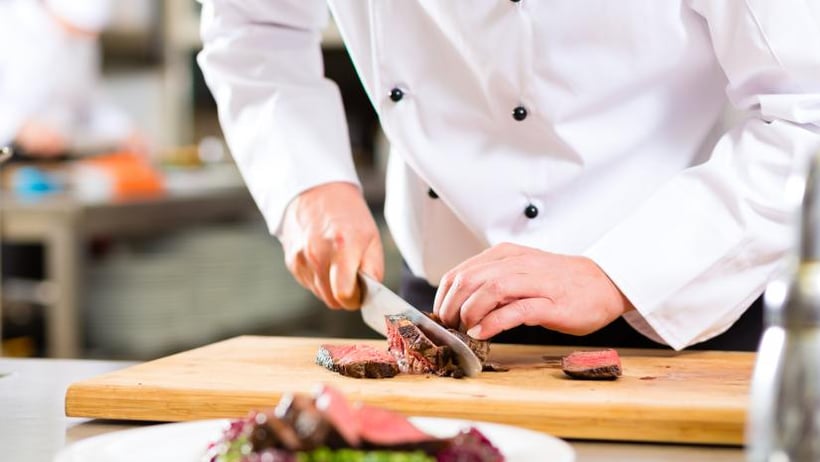
Chopping boards are a staple equipment in almost every kitchen, whether commercial, like in a restaurant or bakery, or residentially. Like any piece of equipment used for food preparation, the chopping board could pose a food safety risk, depending on the type being use and how it is being used by a Food Handler.
Whether preparing food in a commercial kitchen or at home, it’s important to ensure one is taking proper food safety precautions to prevent contamination. Food contamination occurs when a food is affected or spoiled by another substance. There are four main types of contamination: biological (when a food is spoiled by a living organism or the substances they produce), physical (when an object gets into the food), chemical (when a chemical agent such as kitchen cleaner contaminates the food), and cross-contamination (when food or bacteria spreads from foods, hands or surfaces to other foods).
Food preparation surfaces, like chopping boards, pose a cross-contamination risk. That is, they can easily harbour kitchen bacteria and germs from the food being prepared, that can then spread to one’s hands or to other foods prepared on the same surface.
High-risk foods such as raw poultry, fish and meat can contain bacteria and viruses like Salmonella and E.coli – some of the most common causes of food-borne illness. If a cutting board isn’t properly cleaned after preparing such food and then additional food is prepared, there is a risk of spreading those germs. As such, it is essential for food handlers to understand how to best banish bacteria from their kitchen.
Find out more about high-risk foods in our related blog.
Tips for Chopping Board Safety
When using a chopping board to prepare food, follow these steps to ensure safe food handling:
- Don’t prepare ready-to-eat foods on boards used to prepare raw meat
- Use rubber or hard acrylic boards instead of wooden options (wood is more likely to absorb materials)
- Purchase and use different boards for different jobs – such as a red board for raw meat, green for fresh produce, and blue for raw fish
- Dispose of chopping boards that are scratched and cracked, as bacteria can easily hide within the grooves of old boards
- Clean all chopping boards with hot soapy water each and every time that you use them, and especially between preparation of different foods if you’re not using various boards (e.g. after raw chicken, before fresh vegetables)
- Sanitize all chopping boards before putting them away – either with steam or chemical sanitizer
- Try to leave boards to dry naturally after washing, or use paper towels. Tea towels are particularly dangerous when it comes to cross-contamination within the kitchen and need to be regularly washed and replaced.
Food safety training is the best way to ensure you're handling food correctly and safely. For more about food safety training, including more about how to prevent contamination, check out our course page. Don't forget to read up on other sources of contamination in the kitchen, including how to prevent contamination in the refrigerator.
Frequently Asked Questions
How often should chopping boards be replaced to maintain optimal hygiene?
The frequency with which chopping boards should be replaced depends on their condition and the material they are made of. Generally, any chopping board that shows significant signs of wear—such as deep grooves, warping or cracks—should be replaced. These grooves and cracks can harbour bacteria and make thorough cleaning difficult.
For plastic boards, once they become heavily scarred, it’s a good indication that they need to be replaced. Wooden boards can last longer if they are well-maintained but should also be replaced if they show similar signs of wear or damage.
It's good practice to inspect your chopping boards regularly for signs of wear and deep scratches where bacteria can accumulate. If boards are properly maintained, washed and sanitized after each use, they can last longer. However, if they begin to degrade or show signs that cleaning them effectively is becoming difficult, it’s time to consider replacement.
Are there specific sanitizing solutions recommended for effectively disinfecting different types of chopping boards?
Yes, there are specific sanitizing solutions recommended for effectively disinfecting different types of chopping boards:
- Plastic Chopping Boards: Use a solution of bleach and water. Typically, a tablespoon of unscented, liquid chlorine bleach per gallon of water is recommended. Apply the solution after washing the board with soap and water, let it sit for several minutes, then rinse with clean water and air dry or pat dry with clean paper towels.
- Wooden Chopping Boards: Wooden boards are more porous and should not be soaked in water or bleach solutions as these can cause the wood to warp. Instead, wipe them down with a solution of vinegar and water or use a commercially available sanitizer specific for wood. Some also recommend hydrogen peroxide as an effective disinfectant. After cleaning, it’s important to oil the wood regularly to maintain its condition and prevent drying out.
Always ensure the chopping board is thoroughly cleaned with soap and water to remove any food particles before applying sanitizing solutions. After sanitizing, boards should be rinsed (if the cleaning agent requires it) and dried completely to prevent the growth of new bacteria.
What are the risks associated with using the same chopping board for both raw and cooked foods, despite thorough cleaning?
Using the same chopping board for both raw and cooked foods poses several risks:
- Cross-Contamination: This is the primary risk. If the board isn't cleaned and sanitized correctly between uses, bacteria from raw foods (like poultry, meat or seafood) can contaminate ready-to-eat or cooked foods. Bacteria such as Salmonella, E. coli and Listeria are common in raw meats and can easily transfer to other foods, making them unsafe to eat.
- Chemical Residues: If strong chemical sanitizers are used to clean the board between uses, and not thoroughly rinsed, there's a risk of chemical residues contaminating food that comes into contact with the board afterwards.
Inadequate Cleaning: Porous materials like wood can absorb and retain bacteria deep within their surface, where it can survive even a thorough cleaning. This bacteria can then contaminate other foods placed on the board later.
To mitigate these risks, it’s recommended to use separate chopping boards for raw and cooked foods. If using the same board, ensure it is made from a non-porous material, like plastic, which is easier to clean and sanitize effectively.




